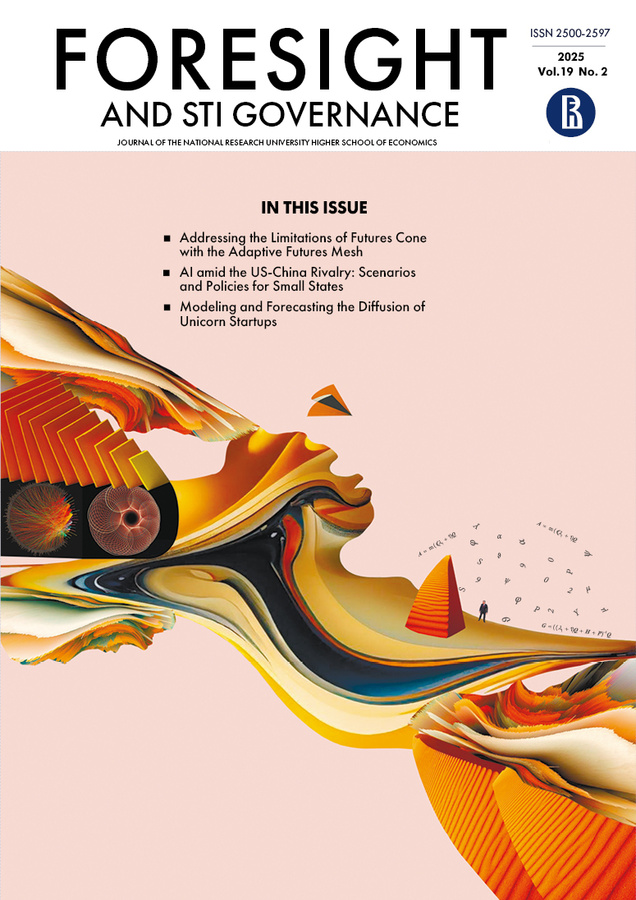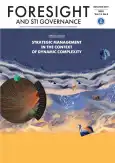Adoption of Industry 4.0 Technologies and Company Competitiveness: Case Studies from a Post-Transition Economy
- Authors: Götz M.1, Jankowska B.2
-
Affiliations:
- Vistula University
- Poznan University of Economics and Business
- Issue: Vol 14, No 4 (2020)
- Pages: 61-78
- Section: NEW BUSINESS MODELS
- URL: https://journal-vniispk.ru/1995-459X/article/view/346969
- DOI: https://doi.org/10.17323/2500-2597.2020.4.61.78
- ID: 346969
Cite item
Abstract
About the authors
Marta Götz
Vistula University
Email: m.gotz@vistula.edu.pl
ul. Stoklosy 3, 02-787 Warsaw, Poland
Barbara Jankowska
Poznan University of Economics and Business
Email: m.gotz@vistula.edu.pl
al. Niepodleglosci 10, 61-875 Poznan, Poland
References
- Amit R., Schoemaker P. (1993) Strategic Assets and Organizational Rent // Strategic Management Journal. Vol. 14. № 1. P. 33-46. Режим доступа: , дата обращения 16.09.2020. DOI:https://doi.org/10.1002/smj.4250140105
- Andriopoulos C., Slater S. (2013) Exploring the landscape of qualitative research in international marketing: Two decades of IMR // International Marketing Review. Vol. 30. № 4. P. 384-412. Режим доступа: , дата обращения 16.09.2020. DOI:https://doi.org/10.1108/IMR-03-2012-0061
- Aquilante T., Bustinza O.F., Vendrell-Herrero F. (2016) Services in European manufacturing: Servinomics explained. Режим доступа:http://bruegel.org/2016/03/services-in-european-manufacturing-servinomics-explained/, дата обращения 16.09.2020.
- Bain J.S. (1956) Barriers to new competition. Cambridge, MA: Harvard University Press.
- Barney J.B., Arikan A.M. (2005) The resource-based view: Origins and implications // The Blackwell Handbook of Strategic Management / Eds. M.A. Hitt, R.E. Freeman, J.S. Harrison. Hoboken, NJ: Wiley-Blackwell. P. 123-182. Режим доступа: , дата обращения 16.09.2020. DOI:https://doi.org/10.1111/b.9780631218616.2006.00006.x
- Benito G.R., Petersen B., Welch L.S. (2019) The global value chain and internalization theory // Journal of International Business Studies. Vol. 50. № 8. P. 1414-1423. DOI:https://doi.org/10.1057/s41267-019-00218-8
- Blumberg B., Cooper D., Schindler P. (2011) Business Research Methods. New York: McGraw-Hill Education.
- Breunig M., Kelly R., Mathis R., Wee D. (2016) Getting the most out of Industry 4.0 operations. Chicago: McKinsey & Company. Режим доступа:https://mck.co/3lCclZB, дата обращения 25.01.2019.
- Burmeister Ch., Lu?ttgens D., Piller F.T. (2016) Business Model Innovation for Industrie 4.0: Why the Industrial Internet Mandates a New Perspective on Innovation // Die Unternehmung. Vol. 2. P. 124-152. Режим доступа: , дата обращения 15.01.2020. DOI:https://doi.org/10.2139/ssrn.2571033
- Cappelli P., Sherer P.D. (1991) The missing role of context in OB: The need for a meso-level approach // Research in Organizational Behavior. Vol. 13. P. 55-110.
- Cattaneo O., Gereffi G., Miroudot S., Taglioni D. (2013) Joining, upgrading and being competitive in global value chains: A strategic framework. Washington, D.C.: The World Bank.
- Chesbrough H. (2006) Open business models: How to thrive in the new innovation landscape. Boston, MA: Harvard Business School Press.
- Collis J., Hussey R. (2009) A practical guide for undergraduate and postgraduate students. New York: Palgrave Macmillan.
- Craig A. (2013) Understanding Augmented Reality. Concepts and Applications (1st ed.). Amsterdam: Elsevier.
- Culot G., Orzes G., Sartor M., Nassimbeni G. (2020) The future of manufacturing: A Delphi-based scenario analysis on Industry 4.0 // Technological Forecasting and Social Change. Vol. 157. Art. 120092. Режим доступа: , дата обращения 15.08.2020. DOI:https://doi.org/10.1016/j.techfore.2020.120092
- Dalenogare L.S., Benitez G.B., Ayala N.F., Frank A.G. (2018) The expected contribution of Industry 4.0 technologies for industrial performance // International Journal of Production Economics. Vol. 204. P. 383-394. DOI:https://doi.org/10.1016/j.ijpe.2018.08.019
- Drath R., Horch A. (2014) Industrie 4.0: Hit or hype? // IEEE Industrial Electronics Magazine. Vol. 8. № 2. P. 56-58. DOI:https://doi.org/10.1109/MIE.2014.2312079
- Edquist H., Goodridge P., Haskel J. (2019) The Internet of Things and Economic Growth in a Panel of Countries // Economics of Innovation and New Technology (в печати, впервые опубликовано онлайн 06.12.2019), Режим доступа: , дата обращения 15.08.2020. DOI:https://doi.org/10.1080/10438599.2019.1695941
- Elteto A., Magashazi A., Szalavetz A., Tury G. (2015) Global Value Chains and Upgrading: The Experience of Hungarian Firms in the Heavy Engineering and Automotive Industries // Competitio. Vol. 14. № 1. P. 5-22. DOI:https://doi.org/10.21845/comp/2015/1/1
- Gancarczyk J., Najda-Janoszka M. (2020) Models for Development of an Innovation Network in Clusters // Problemy Zarzadzania / Management Issues. Vol. 18. № 1. P. 179-192. Режим доступа: , дата обращения 15.08.2020. DOI:https://doi.org/10.7172/1644-9584.87.8
- Gereffi G., Humphrey J., Sturgeon T. (2005) The governance of global value chains // Review of International Political Economy. Vol. 12. № 1. P. 78-104. Режим доступа: , дата обращения 15.08.2020. DOI:https://doi.org/10.1080/09692290500049805
- Gereffi G., Korzeniewicz M. (eds.) (1994) Commodity chains and global capitalism. London: Praeger.
- Gervalla M., Ternai K. ( 2019) The Impact of Industry 4.0 to the ERP Approach // SEFBIS Journal. № 13. P. 56-62.
- Hermann M., Pentek T., Otto B. (2015) Design Principles for Industrie 4.0 Scenarios: A Literature Review (TU Dortmund Working Paper 01).Dortmund: Technische Universita?t Dortmund. Режим доступа:http://www.snom.mb.tu-dortmund.de/cms/de/forschung/Arbeitsberichte/Design-Principles-for-Industrie-4_0-Scenarios.pdf, дата обращения 18.03.2020.
- Holm D., Eriksson K., Johanson J. (1999) Value creation through mutual commitment to business network relationships // Strategic Management Journal. Vol. 20. № 5. P. 467-486. Режим доступа: :5%3C467::AID-SMJ38%3E3.0.CO;2-J, дата обращения 15.08.2020. DOI:https://doi.org/10.1002/(SICI)1097-0266(199905)20
- Humphrey J., Schmitz H. (2002) How does insertion in global value chains affect upgrading in industrial clusters? // Regional Studies. Vol. 36. № 9. P. 1017-1027. Режим доступа: , дата обращения 18.03.2020. DOI:https://doi.org/10.1080/0034340022000022198
- Kagermann H., Wahlster W., Helbig J. (2013) Recommendations for implementing the strategic initiative INDUSTRIE 4.0. Frankfurt/Main: Acatech. Режим доступа:https://www.din.de/blob/76902/e8cac883f42bf28536e7e8165993f1fd/recommendations-for-implementing-industry-4-0-data.pdf, дата обращения 18.03.2020.
- Kovacs O. (2018) The dark corners of industry 4.0 - Grounding economic governance 2.0 // Technology in Society. Vol. 55. P. 140-145. Режим доступа: , дата обращения 18.03.2020. DOI:https://doi.org/10.1016/j.techsoc.2018.07.009
- Lasi H., Fettke P., Kemper H.G., Feld T., Hoffmann M. (2014) Industry 4.0 // Business and Information Systems Engineering. Vol. 6. № 4. P. 239-242. Режим доступа: , дата обращения 18.03.2020. DOI:https://doi.org/10.1007/s12599-014-0334-4
- Lee J., Gereffi G. (2015) Global value chains, rising power firms and economic and social upgrading // Critical Perspectives on International Business. Vol. 11. № 3/4. P. 319-339. Режим доступа: , дата обращения 18.03.2020. DOI:https://doi.org/10.1108/cpoib-03-2014-0018
- Leih S., Linden G., Teece D.J. (2015) Business Model Innovation and Organizational Design: A Dynamic Capabilities Perspective // Business Model Innovation: The Organizational Dimension / Eds. N.J. Foss, T. Saebi. Oxford: Oxford University Press. P. 24-43. :oso/9780198701873.003.0002. DOI:https://doi.org/10.1093/acprof
- Lippman S., Rumelt R.P. (1982) Uncertain imitability: An analysis of interfirm differences in efficiency under competition // Bell Journal of Economics. Vol. 13. № 2. P. 418-438. DOI:https://doi.org/10.2307/3003464
- Lorenz M., Ru?mann M., Strack R., Lueth K., Bolle M. (2015) Man and Machine in Industry 4.0. How Will Technology Transform the Industrial Workforce Through 2025? Режим доступа:https://www.bcg.com/publications/2015/technology-business-transformation-engineered-products-infrastructure-man-machine-industry-4.aspx, дата обращения 20.03.2020.
- Lucke D., Constantinescu C., Westkamper E. (2008) Smart Factory - A Step towards the Next Generation of Manufacturing // Manufacturing Systems and Technologies for the New Frontier / Eds. M. Mitsuishi, K. Ueda, F. Kimura. Heidelberg, New York, Dordrecht, London: Springer: Springer. P. 115-118. Режим доступа: , дата обращения 20.03.2020. DOI:https://doi.org/10.1007/978-1-84800-267-8_23
- Mason E.S. (1939) Price and production policies of large scale enterprises // American Economic Review. Vol. 29. P. 61-74. Режим доступа:https://www.jstor.org/stable/1806955, дата обращения 20.03.2020.
- Miles M.B., Huberman M. (1994) Qualitative Data Analysis: An Expanded Sourcebook. London: SAGE.
- Mowday R.T., Sutton R.I. (1993) Organizational behavior: Linking individuals and groups to organizational contexts // Annual Review of Psychology. Vol. 44. P. 195-229. Режим доступа: , дата обращения 20.03.2020. DOI:https://doi.org/10.1146/annurev.ps.44.020193.001211
- Nosalska K., Piatek Z., Mazurek G., Rzadca R. (2019) Industry 4.0: coherent definition framework with technological and organizational interdependencies // Journal of Manufacturing Technology Management (в печати, впервые опубликовано онлайн 27.11.2019). Режим доступа: , дата обращения 20.03.2020. DOI:https://doi.org/10.1108/JMTM-08-2018-0238
- Penrose E. (1959) The theory of the growth of the firm. Oxford: Blackwell.
- Porter M.E. (1979) The structure within industries and companies' performance // The Review of Economics and Statistics. Vol. 61. № 2. P. 214-227. DOI:https://doi.org/10.2307/1924589
- Porter M.E., Heppelmann J. (2015) How Smart, Connected Products are Transforming Companies // Harvard Business Review. October issue. Режим доступа:https://hbr.org/2015/10/how-smart-connected-products-are-transforming-companies, дата обращения 20.03.2020.
- Porter M.E., Millar V.E. (1985) How information gives you competitive advantage // Harvard Business Review. Vol. 63. P. 149-174. Режим доступа:https://hbr.org/1985/07/how-information-gives-you-competitive-advantage, дата обращения 20.03.2020.
- PwC (2016) Industry 4.0 - Building the Digital Enterprise. London: PricewaterhouseCoopers LLP. Режим доступа:https://www.pwc.com/gx/en/industries/industries-4.0/landing-page/industry-4.0-building-your-digital-enterprise-april-2016.pdf, дата обращения 20.03.2020.
- Qin J., Liu Y., Grosvenor R. (2016) A categorical framework of manufacturing for industry 4.0 and beyond // Procedia CIRP. Vol. 52. P. 173-178. Режим доступа: , дата обращения 20.03.2020. DOI:https://doi.org/10.1016/j.procir.2016.08.005
- Rubera G., Chandrasekaran D., Ordanini A. (2016) Open innovation, product portfolio innovativeness and firm performance: The dual role of new product development capabilities // Journal of the Academy of Marketing Science. Vol. 44. № 2. P. 166-184. DOI:https://doi.org/10.1007/s11747-014-0423-4
- Russmann M., Lorenz M., Gerbert P., Waldner M., Justus J., Engel P., Harnisch M. (2015) Industry 4.0: The Future of Productivity and Growth in Manufacturing. Boston, MA: Boston Consulting Group. Режим доступа:https://image-src.bcg.com/Images/Industry_40_Future_of_Productivity_April_2015_tcm9-61694.pdf, дата обращения 24.08.2020.
- Saarikko T., Westergren U.H., Blomquist T. (2020) Digital transformation: Five recommendations for the digitally conscious firm // Business Horizons (в печати, впервые опубликовано онлайн 15.08.2020). Режим доступа: , дата обращения 24.08.2020. DOI:https://doi.org/10.1016/j.bushor.2020.07.005
- Schmalstieg D., Hollerer T. (2016) Augmented Reality: Principles and Practice (Usability) (1st ed.). Boston, MA: Pearson Education.
- Schuh G., Potente T., Wesch-Potente C., Weber A.R., Prote J.P. (2014) Collaboration Mechanisms to increase Productivity in the Context of Industrie 4.0 // Procedia CIRP. Vol. 19. P. 51-56. Режим доступа: , дата обращения 24.08.2020. DOI:https://doi.org/10.1016/j.procir.2014.05.016
- Siggelkow N. (2007) Persuasion with Case Studies // Academy of Management Journal. Vol. 50. № 1. P. 20-24.
- Skapinyecz R., Illes B., Banyai A. (2018) Logistic aspects of Industry 4.0 // IOP Conference Series: Materials Science and Engineering. Vol. 448 (Proceedings of the XXIII International Conference on Manufacturing, 7-8 June 2018, Kecskemet, Hungary), Article 012014. Режим доступа:https://iopscience.iop.org/article//pdf, дата обращения 24.03.2020. DOI:https://doi.org/10.1088/1757-899X/448/1/012014
- Stead R., Curwen P., Lawler K. (1997) Industrial Economics. Theory, Applications and Policy. London: McGraw-Hill.
- Stemberger M.I., Erjavec J., Manfreda A., Jaklic J. (2019) Patterns of approaches to digital transformation: An institutional arrangements perspective // Economic & Business Review. Vol. 21. № 3. P. 467-492. DOI:https://doi.org/10.15458/ebr.93
- Szalavetz A. (2017a) Upgrading and value capture in global value chains in Hungary: More complex than what the smile curve suggests // Foreign Direct Investment in Central and Eastern Europe: Post-Crisis Perspectives / Ed. S. Balazs. London: Palgrave. P. 127-150. Режим доступа: , дата обращения 24.03.2020. DOI:https://doi.org/10.1007/978-3-319-40496-7_6
- Szalavetz A. (2017b) Industry 4.0 in 'factory economies // Condemned to be left behind? Can Central and Eastern Europe emerge from its low-wage model? / Eds. B. Galgoczi, J. Drahokoupil. Brussels: ETUI. P. 133-152. Режим доступа:https://www.etui.org/sites/default/files/Chapter%205_6.pdf, дата обращения 24.03.2020.
- Tchoffa D., Figay N., Ghodous P., Exposito E., Kermad L., Vosgien T., El Mhamedi A. (2016) Digital factory system for dynamic manufacturing network supporting networked collaborative product development // Data & Knowledge Engineering. Vol. 105. P. 130-154. Режим доступа: , дата обращения 24.03.2020. DOI:https://doi.org/10.1016/j.datak.2016.02.004
- Teece D.J. (2017) Towards a capability theory of (innovating) firms: Implications for management and policy // Cambridge Journal of Economics. Vol. 41. № 3. P. 693-720. Режим доступа: , дата обращения 24.03.2020. DOI:https://doi.org/10.1093/cje/bew063
- WEF (2019) White Paper Global Lighthouse Network: Insights from the Forefront of the Fourth Industrial Revolution. Geneva: World Economic Forum, McKinsey. Режим доступа:http://www3.weforum.org/docs/WEF_Global_Lighthouse_Network.pdf, дата обращения 20.03.2020.
- Wang S., Wan J., Li D., Zhang Ch. (2016) Implementing Smart Factory of Industrie 4.0: An Outlook // International Journal of Distributed Sensor Networks. Vol. 12. № 1, art. 3159805. Режим доступа: , дата обращения 24.03.2020. DOI:https://doi.org/10.1155/2016/3159805
- Wernerfelt B. (2013) Small Forces and Large Firms: Foundations of the RBV // Strategic Management Journal. Vol. 34. № 6. P. 635-643. Режим доступа: , дата обращения 24.03.2020. DOI:https://doi.org/10.1002/smj.2043
- West J., Salter A., Vanhaverbeke W., Chesbrough H. (2014) Open innovation: The next decade // Research Policy. Vol. 43. № 5. P. 805-811. Режим доступа: , дата обращения 24.03.2020. DOI:https://doi.org/10.1016/j.respol.2014.03.001
- Zielinski M. (2016) Przemysl 4.0 w polskich fabrykach [Industry 4.0 in Polish factories]. Режим доступа:https://www.astor.com.pl/biznes-i-produkcja/raport-przemysl-4-0-polskich-fabrykach/, дата обращения 20.03.2020 (in Polish).
- Zott C., Amit R., Massa L. (2011) The Business Model: Recent Developments and Future Research // Journal of Management. Vol. 37. № 4. P. 1019-1042. Режим доступа:https://doi.org/10.1177%2F0149206311406265, дата обращения 20.03.2020.
Supplementary files









